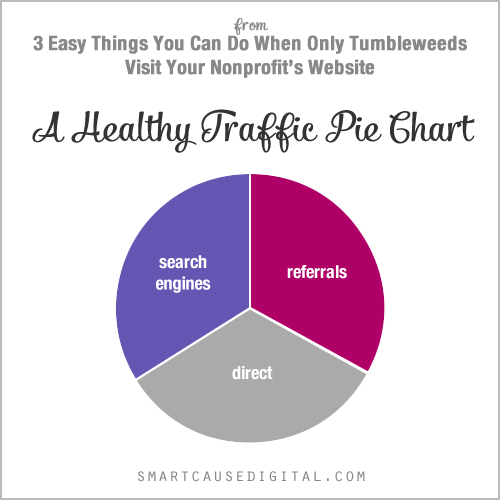(Note: This resource is specifically created to help you improve your organization’s fundraising. If you’re looking for a more general resource to get started with website analytics, check out my article: 6 Metrics I Track on Nonprofit Websites & Why They’re Important)
If you’re not sure whether your donation form is any good…
If you’re wondering what attracts your donor to your organization…
If you don’t know off which of your outreach efforts brings in the most online donors…
You can find the answers, and raise more dollars, by learning a few basic principles of website analytics.

Lesson 1: How She Found You
There are three main sources for website traffic: Search, Referral and Direct.

Search represents people who found your site via a search engine, usually Google. These are people who are interested in the content that you have to offer, and who are probably new to your organization. For you as a fundraiser, these people are potential leads!
Referral represents people who found your site via a link on another website, such as a city government site or a blog. These are people who are interested in the content that you have to offer, who are probably new to your organization and who have been sent to your site via a recommendation on another site. For you as a fundraiser, these people are warm leads!
Direct represents Google’s “I don’t really know” category. In practice, these people probably have a bookmark to your site, or they already know the URL. For you as a fundraiser, these people represent current supporters.
If you find that your Search or Referral pie slices are a small percentage of your overall traffic, invest in growing those segments! (Need help? Scroll down for the link to my Google Analytics mini-course.)
More traffic from search and referral sources → more leads → more donors → more dollars raised.
Lesson 2: What’s Important to Her
One of my favorite parts of my former life as a fundraiser was meeting our members and donors in-person. I loved chatting with them, learning about which issues were important to them, and why they chose to share their precious time and money with our organization.
I walked away with ideas that influenced my next appeal letter or tshirt design.
I find a lot of the same insight in my website’s analytics!
If you want to know what’s important to your donor, check out the list of top landing pages on your site.
A landing page is the first page that a visitor sees when she arrives on your site. The landing page is the content that initially attracted her to your site.
Which pages and posts are attracting the most visitors to your website? What common themes do the landing pages share?
Once you identify the key themes that attracts people to your website, you can incorporate the themes into future blog posts, call-to-action language, advertisements, etc.
Every so often, new themes rise in popularity. Update your language to match, and your donor will be excited to see just how well you understand her!
Lesson 3: How Bad is Your Donation Form, Really?
Or, how good is your donation form, really? The only way to know is to measure your conversion rate.
A conversion rate is a percentage of visitors who complete a specific action.
For example, on your nonprofit website, you would measure the conversion rate of visitors that actually make an online donation.
As a fundraiser, you’re familiar with the “response rate” for your direct mail pieces. The “conversion rate” falls into the same family.
When you know your website’s conversion rate, you understand whether your donation form is effective, or whether it needs improvement.
Just like with response rates, conversion rates for nonprofits can vary widely. So it doesn’t matter what your conversion rate is, as long as you keep improving it over time.
Better conversion rates equals more dollars raised!
Need a more comprehensive tutorial to get started with Google Analytics?
Come on over and sign up for my free Google Analytics mini-course!
Look for an invitation to my upcoming Complete Google Analytics Toolkit training. I take you from intro to advanced so you can understand the information in Google Analytics and customize the tool to fit your specific needs.

